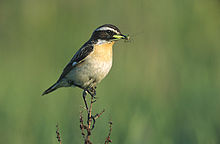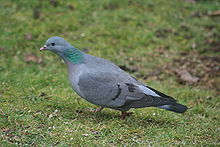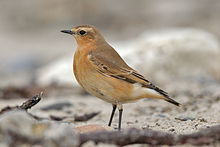Middle Swabian Alb
|
Bird sanctuary (SPA)
"Middle Swabian Alb" |
||
|
The Middle Swabian Alb near the Schopfloch peat bog |
||
| location | Alb-Donau-Kreis , district of Esslingen , Göppingen district , the district of Reutlingen , Tübingen district and Zollernalbkreis , Baden-Wuerttemberg , Germany | |
| WDPA ID | 555537899 | |
| Natura 2000 ID | DE-7422-441 | |
| Bird sanctuary | 395.973 km² | |
| Geographical location | 48 ° 34 ' N , 9 ° 31' E | |
|
|
||
| Setup date | November 20, 2007 | |
| administration | Regional Council Tübingen | |
The area Central Swabian Alb is a 2007 equipped with Regulation of 5 February 2010 by the Ministry of Food and Rural Areas specified European bird sanctuary (reserve identifier DE-7422-441) in parts of Württemberg Baden- districts Esslingen , Göppingen , Reutlingen , Tübingen , the Alb-Donau district and the Zollernalb district in Germany .
description
The Middle Swabian Alb area is described as a “diverse cultural and natural landscape with extensively used field and forest landscapes, semi-open juniper heather and stone bar hedge landscapes, beech, steppe heather and steep slope forests, white Jura rock belts and orchards”.
Habitat classes
| Non-forest areas with wooden plants, scrub, etc. | 3% | |||
| Deciduous forest | 8th % | |||
| Mixed forest | 57% | |||
| Coniferous forest | 1 % | |||
| Meliorated grassland, dry grass, heather, scrub | 24% | |||
| Inland rocks, rubble and rubble heaps, sandy areas | 1 % | |||
| Different farmland | 5% | |||
| Other (cities, roads, landfills, pits, industrial areas) | 1 % | |||
location
The approximately 39,597 hectare (ha) bird sanctuary in the Middle Swabian Alb is spread over 16 cities , 34 municipalities and an area free of municipalities in the five districts
-
Alb-Danube district (154.7 ha)
- Communities Heroldstatt (57.02 ha) and Western Home
- Towns of Laichingen (64.50 ha) and Schelklingen (33.14 ha)
-
Esslingen (5,804.5 ha)
- Municipalities of Beuren (197.91 ha), Bissingen an der Teck (737.86 ha), Erkenbrechtsweiler (552.54 ha), Kohlberg (19.01 ha), Lenningen (2,446.71 ha), Neidlingen (577.88 ha ),
- Cities Neuffen (434.14 ha), Owen (183.77 ha) and Weilheim an der Teck (654.70 ha)
-
Göppingen (12,642.5 ha)
- Municipalities of Aichelberg (97.17 ha), Bad Boll (368.25 ha), Bad Ditzenbach (1,396.95 ha), Bad Überkingen (1,997.60 ha), Böhmenkirch (381.28 ha), Deggingen (1,664.79 ha ), Dürnau (133.28 ha), Eschenbach (51.91 ha), Gammelshausen (89.33 ha), Gingen an der Fils (259.76 ha), Gruibingen (2,037.48 ha), Heiningen (214.78 ha) ha), Kuchen (312.50 ha), Mühlhausen im Täle (243.09 ha), Schlat (290.68 ha) and Zell unter Aichelberg (0.48 ha)
- Cities Donzdorf (3.00 ha), Geislingen an der Steige (1,300.30 ha), Göppingen (7.56 ha), Süßen (327.55 ha) and Wiesensteig (1,464.70 ha)
-
Reutlingen (18,988.2 ha)
- Municipalities of Dettingen an der Erms (593.37 ha), Engstingen (218.14 ha), Eningen unter Achalm (1,012.26 ha), Grabenstetten (1,074.43 ha), Hülben (481.78 ha), Lichtenstein (1,815, 57 ha), Münsingen (179.42 ha), Römerstein (121.09 ha), St. Johann (268.47 ha) and Sonnenbühl (1,430.10 ha)
- Community-free area Guts Bezirk Münsingen (6,120.43 ha)
- Cities Bad Urach (3,111.59 ha), Metzingen (371.98 ha), Pfullingen (1,391.53 ha) and Reutlingen (798.00 ha)
-
Tübingen (1,696.8 ha)
- Large district town Mössingen (1,696.8 ha)
-
Zollernalbkreis (310.6 ha)
- City of Burladingen (310.60 ha)
Protection purpose
The area-related conservation objectives are described differently depending on the species :
Tree falcon ( Falco subbuteo )
Preservation of light forests with bordering open landscapes, of old trees and islands of old wood, of overhangs, of field trees or groups of trees in fields or along waterways, of extensively used grassland, of waterways with structurally rich bank areas and silting areas, of nesting opportunities such as crow's nests, of the food supply, in particular with small birds and large insects as well as undisturbed or at least undisturbed breeding sites during the breeding season from April 15 to September 15.
Berg Laubsänger ( Phylloscopus Bonelli )
Preservation of light, tiered forest stands on warm, south-exposed, steeply sloping slopes with rock sections as well as rock rubble heaps or erosion sites with a sparse layer of shrubbery and abundant herbaceous layer, the steppe heath areas with sparse trees, changing layers of shrubbery and closed lawns during the breeding season, as well as trouble-free or at least disruptive areas April 15th and August 15th.
Whinchat ( Saxicola rubetra )
Preservation of largely late-mowed extensively managed grassland complexes, large sedge areas, moors and heaths, fringing strips such as road and field borders as well as edge strips, old grass strips, fallow and wood-free embankments, isolated bushes, tall perennials, piles of stones and others as hunting, sitting and Singwarten suitable structures, secondary habitats such as abandoned mining sites with the aforementioned habitats, the food supply as well as undisturbed or at least undisturbed breeding sites during the breeding season from May 1 to August 31.
Gray bunting ( Emberiza calandra )
Preservation of grassland areas and richly structured fields, fallow land, strips of field margins as well as grass and shrub fringes, grass and earth paths, field hedges, solitary trees and bushes, preservation of the food supply, in particular with insects as nestling food and wild herb seeds as well as preservation of undisturbed or at least undisturbed breeding sites during the breeding season (April 15 to August 31).
Gray woodpecker ( Picus canus )
Preservation of richly structured light deciduous and mixed deciduous forests with open areas for feeding, of alluvial forests, of extensively cultivated orchards, preservation of poor grasslands, poor hay meadows or cattle pastures, preservation of edge strips, rain areas, embankments and lined, stepped forest edges, of old wood islands and old wood islands , especially of standing dead wood, preservation of trees with large caves and the food supply.
Collared Flycatcher ( Ficedula albicollis )
Preservation of extensively managed orchards with a high proportion of pome fruit, light deciduous and alluvial forests, old trees and islands of old wood, trees with caves and the maintenance of the food supply, especially with insects.
Woodlark ( Lullula arborea )
Preservation of large-scale poor and dry grasslands as well as heaths, preservation of larger forest clearings, of bristle grass lawns and winged gorse heaths, of dry, sunny areas with little or no vegetation, preservation of a gaps and light vegetation structure with isolated bushes and trees, preservation of edge and border structures as well as fallow land, of secondary habitats such as abandoned sand and gravel pits with extensive raw soil locations, maintenance of the food supply, especially with insects in the summer half-year, and maintenance of undisturbed or at least undisturbed breeding sites during the breeding season in the period from February 15 to August 15.
Stock dove ( Columba oenas )
Preservation of deciduous and mixed deciduous forests, of old trees and old wood islands, of trees with large caves as well as grassland areas and extensively used fields with fallow land, strips of field margins and weed-rich grass borders.
Common teal ( anas crecca )
Preservation of the eutrophic, vegetation-rich shallow water lakes, small bodies of water, backwaters and wet meadow ditches leading to water, the slow-flowing bodies of water with shallow water zones, the vegetation-rich moor lakes, the silted areas with reed beds, sedge beds, water-bearing trees, silt areas and shallow water zones, preservation of secondary habitats such as abandoned mining sites Preservation of undisturbed or at least undisturbed breeding or moulting sites during the breeding and rearing season (March 15 to August 31) and the moult (July 1 to September 30).
Middle Woodpecker ( Dendrocopos medius )
Preservation of deciduous and mixed deciduous forests, especially those with oak, of alluvial and alder forests, of extensively cultivated orchards, of old trees and islands of old wood, of standing dead wood and trees with caves.
Red- backed shrike ( Lanius collurio )
Preservation of extensively managed orchards, grassland and heathland areas, of low and medium hedges from native species, in particular thorn or prickly wooded trees, preservation of litter meadows and open bog edges, preservation of individual trees and bushes in the open landscape, of field lines, grass paths, Ruderal and perennial corridors and fallow land, field and meadow margins, secondary habitats such as abandoned mining sites with the aforementioned habitats and maintenance of the food supply, especially with larger insects.
Northern gray shrike ( Lanius excubitor )
Preservation of extensive, extensively managed orchards with numerous bushes, of hedge areas with the small structures there such as stone hedges, small fallow land, swampy depressions, individual bushes and trees, unpaved field paths, preservation of grazed juniper heaths with groups of bushes and trees, preservation of lean grassland, of wasteland - and fallow land as well as fringing strips, preservation of the moors with bushes and break forest islands, the springy places and swampy depressions, preservation of uncut landscapes, in particular without paved paths and roads, preservation of the food supply, especially with small mammals and large insects as well as preservation of undisturbed or at least undisturbed breeding sites during the breeding season from February 15th to July 15th.
Little Owl ( Aegolius funereus )
Preservation of structurally rich and large-area coniferous or mixed forests, in particular mixed coniferous forests rich in beech, of mosaics from light old wood stocks and clearings as well as pole wood and thickening areas, of standing dead wood with large trunk diameters, preservation of trees with large caves as well as preservation of undisturbed or at least undisturbed breeding sites during the breeding season March 1st to August 1st.
Red kite ( Milvus milvus )
Preservation of diversely structured cultural landscapes with sparse forests, of field trees, large individual trees and rows of trees in the open landscape, of grassland, of old wood islands and old, large-crowned trees with free approach, preservation of trees with clumps, habitats without sources of danger such as non-bird-safe overhead lines and Wind turbines and the maintenance of undisturbed or at least low-disturbance breeding sites during the breeding season from March 1st to August 31st.
Black kite ( Milvus migrans )
Preservation of diversely structured cultural landscapes, of sparse forests, in particular alluvial forests, of field trees, large individual trees and rows of trees in the open landscape, grassland, islands of old wood and old, large-crowned trees with free approach, especially near the forest edge, preservation of natural flowing and still waters, conservation of trees with clumps, of habitats without sources of danger such as non-bird-safe overhead lines and wind turbines as well as maintenance of undisturbed or at least undisturbed breeding sites during the breeding season from March 1st to August 15th.
Black Woodpecker ( Dryocopus martius )
Preservation of extensive forests, old trees and islands of old wood, dead wood, preservation of trees with large caves as well as the food supply, especially with ants.
Pygmy Owl ( Glaucidium passerinum )
Preservation of structurally rich and large-area coniferous or mixed forests, of mosaics from light old wood stocks and clearings as well as pole wood and thicket areas, of old trees and islands of old wood, of trees with caves, of standing dead wood as well as preservation of natural or near-natural water bodies such as streams and preservation of moors.
Wheatear ( Oenanthe oenanthe )
Preservation of extensively used meadow and arable areas with piles of stone piles or bars and cattle pastures, in particular sheep pastures, preservation of heath areas, preservation of areas free or poor in vegetation, of secondary habitats such as abandoned mining sites with the aforementioned habitats, preservation of the food supply, especially with insects, as well as preservation of undisturbed areas or at least low-disturbance breeding sites during the breeding season between April 15th and August 15th.
Eagle owl ( Bubo bubo )
Preservation of open rock walls and quarries, each with caves, niches and ledges, preservation of richly structured cultural landscapes in the vicinity of the aforementioned habitats, of open meadow areas with hedges, preservation of habitats without sources of danger such as non-bird-safe overhead lines and wind turbines as well as disruption-free or at least disruption-free reproductive and resting places.
Quail ( Coturnix coturnix )
Preservation of a richly structured cultural landscape, preservation of widely used arable land, extensively used grassland, in particular of lean grassland with gaps in vegetation structure and a high proportion of herbs, small areas of land with sparse vegetation such as gussets, waterlogged small depressions, sinkholes, swelling patches, small hollows, stone fields , Patches of poor grassland and stone bars, from weed-rich field margins and smaller fallow land, grass, reed and perennial edges as well as maintaining the food supply, especially with various seeds and insects.
Peregrine falcon ( Falco peregrinus )
Preservation of the open rock walls and quarries with caves, niches and ledges, preservation of habitats without sources of danger such as non-bird-safe overhead lines and unsecured chimneys as well as preservation of undisturbed or at least undisturbed breeding sites during reproduction in the period from February 15 to July 30.
Reversible neck ( Jynx torquilla )
Preservation of loosened deciduous, mixed and pine forests in dry locations as well as alluvial forests with clearings or on the edge of open land, preservation of extensively managed orchards, grasslands, heather and stone bar hedge areas, of lean hay meadows or cattle pastures as well as wooded fields, preservation of temporary differentiated uses in grassland, of old trees and old wood islands, of trees with caves, preservation of edge strips, rainen, embankments and fringed stepped forest edges as well as preservation of the food supply, especially with meadow ants.
Honey buzzard ( Pernis apivorus )
Preservation of diversely structured cultural landscapes, light deciduous and mixed and pine forests, field trees, extensively used grassland, old wood islands and old, large-crowned trees with free approach, preservation of the poor grasslands, trees with clumps, preservation of the food supply, especially with wasps and bumblebees that form states as well as the maintenance of undisturbed or at least low-disturbance breeding sites during the breeding season from May 1st to August 31st.
Yellow wagtail ( Motacilla flava )
Preservation of a mosaic of arable land with various crops, preservation of the silting zones on bodies of water, preservation of edge structures at usage boundaries such as grass, reed and perennial borders at the edges of paths and fields, but also of fallow land, of temporally differentiated uses in grassland, of isolated bushes, Tall perennials and other structures suitable for hunting, sitting and singing stations, secondary habitats such as abandoned mining sites with the aforementioned habitats, as well as maintaining the food supply, in particular with insects.
See also
Web links
- Standard data sheet for the bird sanctuary "Middle Swabian Alb"
- Profile of the SPA area Middle Swabian Alb in the LUBW's list of protected areas
Individual evidence
- ↑ Ordinance of the Ministry of Food and Rural Areas establishing European bird protection areas (VSG-VO). Retrieved August 22, 2018 .
- ↑ The city of Hechingen is also mentioned in the Bird Protection Area Ordinance, but this is de facto not affected. The bird sanctuary only extends as far as the municipal boundary; the Hechinger district is followed by the bird sanctuary Südwestalb and Oberes Donautal .
- ↑ Annex 1 of the ordinance of the Ministry of Food and Rural Areas establishing European bird protection areas (VSG-VO) of February 5, 2010. Accessed on August 22, 2018 .








